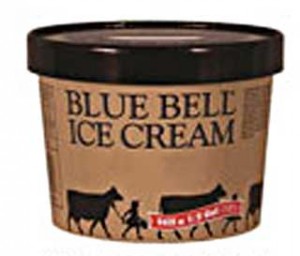According to two letters sent to the FDA in mid-February, 2016, Blue Bell thinks they have identified where the Listeria monocytogenes bacteria were living in two of its plants last year. But the problem areas were redacted in the letters that the FDA published recently, to “protect trade secrets.” The company found the pathogenic bacteria in equipment at its Brenham, Texas plant and thinks it spread in the drainage system of the plant in Broken Arrow, Oklahoma.
 The deadly Listeria monocytogenes outbreak linked to Blue Bell products prompted a massive recall of all of Blue Bell’s products. All three plants were shut down for months last summer. The company started producing and selling ice cream again in August 2016 after an investor stepped up to help them out. Ten people in four states were sickened in this outbreak; three patients died.
The deadly Listeria monocytogenes outbreak linked to Blue Bell products prompted a massive recall of all of Blue Bell’s products. All three plants were shut down for months last summer. The company started producing and selling ice cream again in August 2016 after an investor stepped up to help them out. Ten people in four states were sickened in this outbreak; three patients died.
In the report on the Brenham facility, company officials state, “We identified several potential or likely source of Listeria to the product based on our investigation, sampling, and analyses. These potential sources varied by production link and included equipment such as ___ and specific pieces of equipment, such as the ___ and the ___ machine. Individual pieces of equipment were addressed – some were disassembled and thoroughly cleaned, others were taken out of commission and removed from the facility. Although we took remedial action on individual pieces of equipment, it became evident that we would not be able to identify a single source to our entire Brenham facility, turning our focus to facility-wide remediation efforts intended to prevent the reintroduction and reestablishment of Listeria in our facility.”
At the Broken Arrow facility, company officials say that Listeria monocytogenes bacteria spread through the drainage system and was released into the air. Then, equipment stored “outside the sanitary production area,” or in the room with the drain, may have been contaminated.
Blue Bell has been using what it calls “enhanced sanitation and testing procedures,” and said they now have a “test and hold” procedure conducted before the ice cream is released into the market. Listeria monocytogenes bacteria is extremely difficult to eradicate once it takes hold in a facility. The bacteria form biofilms that protect it from cleaners and sanitizing products. And the bacteria can grow at refrigerator temperatures.
The letters end with a summary of their findings, stating that Listeria likely entered the facility from various potential sources “and was established on some pieces of equipment” in Brenham, and “became present in the drain system” in Broken Arrow. At the Broken Arrow facility, Blue Bell is identifying a “more appropriate storage location for equipment, cleaning and sanitizing the production and processing areas of our facility, and equipment, and enhancing our sanitation procedures and testing programs to protect against reintroduction of Listeria.”
At the Brenham facility, Blue Bell is “addressing individual pieces of equipment that returned presumptive positive test results, cleaning and sanitizing our entire facility and equipment, and enhancing our sanitation procedures and testing programs to protect against reintroduction of Listeria.” Both letters end with the same statement: “We believe that these enhanced programs are enabling us to effectively control for Listeria in our [facilities].”
The symptoms of Listeria monocytogenes food poisoning include flu-like fever and muscle aches, upset stomach or diarrhea, stiff neck, headache, loss of balance, and confusion. Pregnant women may only have a mild illness, but listeriosis can cause serious problems such as miscarriage, stillbirth, premature labor, and infection in the newborn baby.




